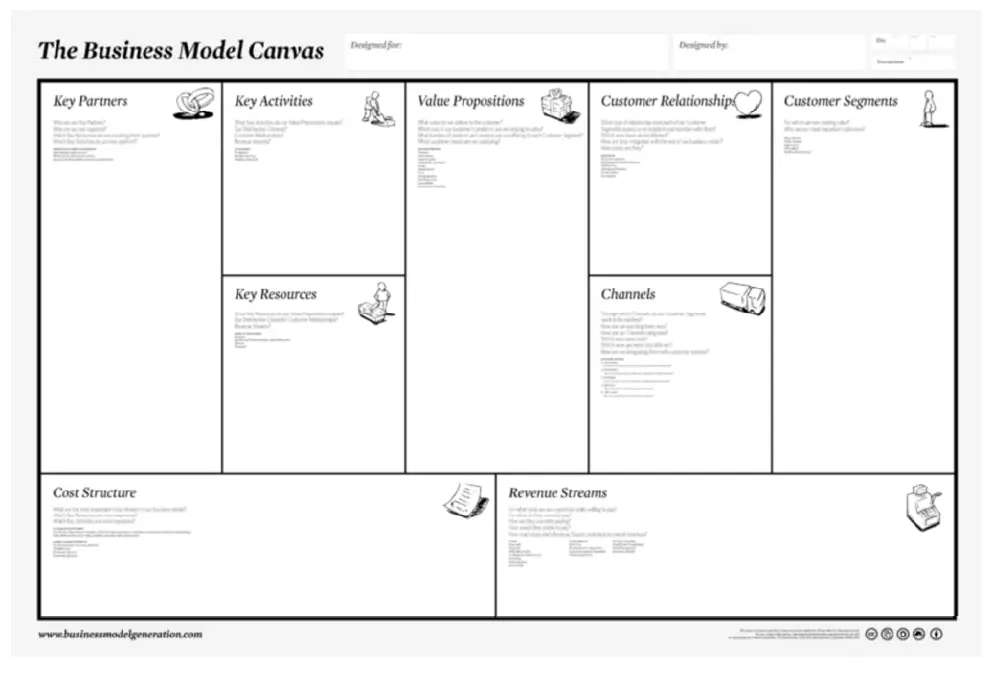The Business Model Canvas
Osterwalder has created a canvas based on nine building blocks depicted in a business model canvas. They are:
- Customer value proposition
- Customer segments
- Channels
- Customer relationships
- Revenue streams
- Key resources
- Key partners
- Key activities
- Cost structure.
If you are able to describe each of these nine building blocks, you will have a clear picture of your business. The idea is that having everything in one-sheet enables you to get a good overview of all elements of your business.

Source: Business Model Canvas: nine business model building blocks, Osterwalder, Pigneur & al. 2010
The canvas includes the customer or the demand side as well as the supply side. The demand site is depicted on the right side and includes Customer segments, Customer relations and Channels. The supply side is depicted on the left side, and it includes Key partners, Key activities, and Key resources. The value proposition is depicted in the middle, but it is normally seen as belonging to the demand side. At the bottom we find the financial factors: Cost structure (depending on the supply) and Revenue streams (depending on the demand).
The Customer value proposition is a key factor for any business model. It describes the value of your product or service for the customer and explains why the customer will choose your product instead of turning to your competitors. Here you should explain why your product is better than any other existing alternatives on the market. Some Value Propositions may be innovative and represent a new or disruptive offer. Others may be similar to existing market offers, but with new features and attributes added.
In the Customer segments field you must specify who your target customers are. The customer segment can be defined according to location (local, regional, national, or global), according to age group, income group or psycho-graphic characteristics.
The Channels Building Block describes how you will communicate with and reach the Customer Segments defined above. Channels are customer touch points that play an important role in the customer experience. This includes marketing channels as well as channels for delivering products or services. Communication with customers includes raising awareness among customers about a company’s products and services; and enabling customer feed-back on the Value Proposition.
The channels include also channels through which the customer can purchase specific products and services and delivery of a Value Proposition to customers. Examples of channels can be the World Wide Web or a physical with a specific location.
Delivery of after sale services is also included in this building block.
Customer relationships includes the relationship with customers in all phases of the transaction:
- Customer acquisition
- Customer retention
- Boosting sales (up-selling)
Customer relations can be either personal or automated. It is important to specify, whether your company wants to focus on one-time customers or customers who may perform several repeating transactions over time. For certain business models customer relations forms an important part of the perceived customer value proposition.
The Revenue streams denote the streams of income for the company. Revenues are generated through payments from customers. These payments may be generated through purchase of specific products or services, but other payment models are possible. New innovative business models have been created through creation of new ways to generate revenue from products or services existing on the market already.
Key resources describes the most important assets you need for setting up and operating your company. There can be many very different types of key assets. In almost any kind of business, financial means will be a key asset. Key resources will however often include particular skills, intellectual property rights or patents as well. Access to inexpensive labor with adequate skills can also be a key resource.
Key partners include suppliers as well as well as others, who you depend on for carrying out your business operations. Key partners may in certain cases include competitors as well. The way you collaborate with key partners and your relative strength in relation to them may be important for your chances for maintaining a profitable business. Key partners may help you to be introduced at new markets, but they may also be able to squeeze your profit through unfair pricing.
Key activities include key operations to make your business model work. The kinds and organization of key activities differ substantial from business to business. In a brick and mortar production company, key activities may include standard routine operations, as the most important activity. In other companies customer handling or research and development will be in focus. The organization and company structure must reflect the different kinds of key activities.
The Cost structure includes all costs incurred by the operations of the company. This includes the costs of key activities as well as the costs of supplies, customer relations, delivery channels etc. An important aspect of the costs are whether they have to be covered up-front and whether they are scale dependent.
A key aspect of the creation of a viable business is to analyze the relation between the different building blocks. The advantage of the business model canvas is that it provides an overview of all elements of the business model at one sheet.
